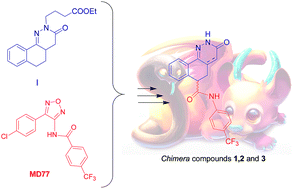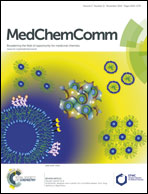Modeling, synthesis and NMR characterization of novel chimera compounds targeting STAT3†
Abstract
Signal Transducer and Activator of Transcription 3 (STAT3) is a cytoplasmic factor that mediates intracellular signaling commonly generated at cell surface receptors and transmits it to the nucleus. In previous research studies we synthesized several molecules inhibiting STAT3 and among them oxadiazole MD77 and pyridazinone I showed an interesting activity. For the first one, a direct inhibition mechanism was determined, while I interfered within the STAT3 pathway at a different level. In order to discover novel compounds possibly endowed with an improved activity, we decided to merge their scaffolds on the basis of their calculated conformational properties. Therefore we designed and synthesized the chimera diastereomers 3-oxo-N-(4-(trifluoromethyl)phenyl)-2,3,4,4a,5,6-hexahydrobenzo[h]cinnoline-6-carboxamide (1, 2) and 3-oxo-N-(4-(trifluoromethyl)phenyl)-2,3,5,6-tetrahydrobenzo[h]cinnoline-6-carboxamide (3) as racemate and their enantiomeric separation was performed. Modeling studies and theoretical prediction of [α]D values were carried out beside NMR studies which allowed us to assign 1 and 2 relative configurations.


 Please wait while we load your content...
Please wait while we load your content...